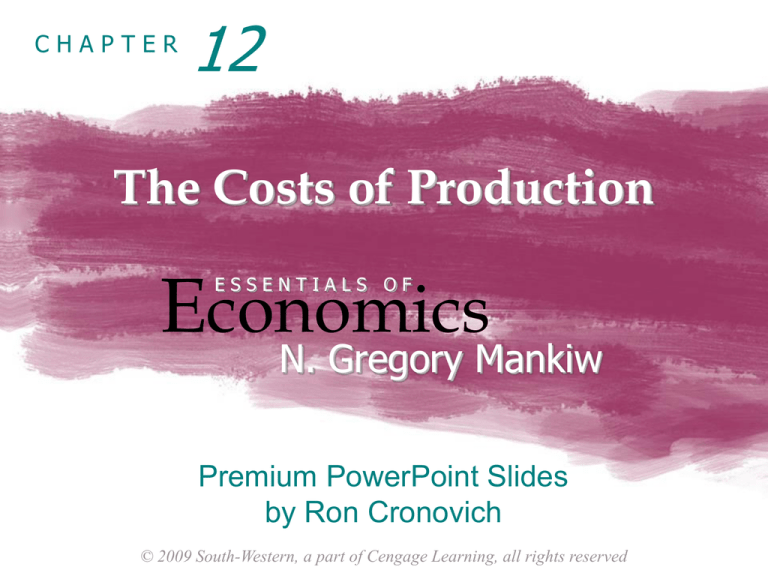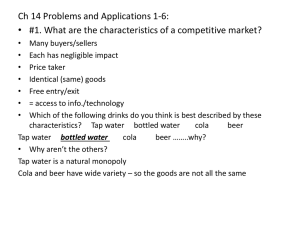
CHAPTER
12
The Costs of Production
Economics
ESSENTIALS OF
N. Gregory Mankiw
Premium PowerPoint Slides
by Ron Cronovich
© 2009 South-Western, a part of Cengage Learning, all rights reserved
ACTIVE LEARNING
1
Brainstorming costs
You run General Motors.
List 3 different costs you have.
List 3 different
business decisions
that are affected
by your costs.
1
In this chapter,
look for the answers to these questions:
What are the various costs, and how are they
related to each other and to output?
How are costs different in the short run vs.
the long run?
2
What are Costs?
Total revenue
Amount a firm receives for the sale of its output
Total cost
Market value of the inputs a firm uses in
production
Profit
Total revenue minus total cost
3
What are Costs?
Costs as opportunity costs
The cost of something is what you give up to get
it
Firm’s cost of production
Include all the opportunity costs
Making its output of goods and services
4
Costs: Explicit vs. Implicit
Explicit costs require an outlay of money,
e.g., paying wages to workers.
Implicit costs do not require a cash outlay,
e.g., the opportunity cost of the owner’s time.
Remember one of the Ten Principles:
The cost of something is
what you give up to get it.
This is true whether the costs are implicit or
explicit. Both matter for firms’ decisions.
THE COSTS OF PRODUCTION
5
What are Costs?
Economic profit
Total revenue minus total cost
Including both explicit and implicit costs
Accounting profit
Total revenue minus total explicit cost
6
ACTIVE LEARNING
2
Economic profit vs. accounting profit
The equilibrium rent on office space has just
increased by $500/month.
Compare the effects on accounting profit and
economic profit if
a. you rent your office space
b. you own your office space
7
ACTIVE LEARNING
2
Answers
The rent on office space increases $500/month.
a. You rent your office space.
Explicit costs increase $500/month.
Accounting profit & economic profit each fall
$500/month.
b. You own your office space.
Explicit costs do not change,
so accounting profit does not change.
Implicit costs increase $500/month (opp. cost
of using your space instead of renting it),
so economic profit falls by $500/month.
8
The Various Measures of Cost
Fixed costs
Do not vary with the quantity of output produced
Variable costs
Vary with the quantity of output produced
Average fixed cost (AFC)
Fixed cost divided by the quantity of output
Average variable cost (AVC)
Variable cost divided by the quantity of output
9
Marginal Cost
Marginal Cost (MC)
is the increase in Total Cost from
producing one more unit:
∆TC
MC =
∆Q
THE COSTS OF PRODUCTION
10
Why MC Is Important
Farmer Jack is rational and wants to maximize
his profit. To increase profit, should he produce
more or less wheat?
To find the answer, Farmer Jack needs to
“think at the margin.”
If the cost of additional wheat (MC) is less than
the revenue he would get from selling it,
then Jack’s profits rise if he produces more.
THE COSTS OF PRODUCTION
11
Costs in the Short Run & Long Run
Short run:
Some inputs are fixed (e.g., factories, land).
The costs of these inputs are FC.
Long run:
All inputs are variable
(e.g., firms can build more factories,
or sell existing ones).
In the long run, ATC at any Q is cost per unit
using the most efficient mix of inputs for that Q
(e.g., the factory size with the lowest ATC).
THE COSTS OF PRODUCTION
12
EXAMPLE 3: LRATC with 3 factory Sizes
Firm can choose
from 3 factory
sizes: S, M, L.
Avg
Total
Cost
Each size has its
own SRATC curve.
The firm can
change to a
different factory
size in the long
run, but not in the
short run.
THE COSTS OF PRODUCTION
ATCS
ATCM
ATCL
Q
13
EXAMPLE 3: LRATC with 3 factory Sizes
To produce less
than QA, firm will
choose size S
in the long run.
Avg
Total
Cost
To produce
between QA
and QB, firm will
choose size M
in the long run.
To produce more
than QB, firm will
choose size L
in the long run.
THE COSTS OF PRODUCTION
ATCS
ATCM
ATCL
LRATC
QA
QB
Q
14
A Typical LRATC Curve
In the real world,
factories come in
many sizes,
each with its own
SRATC curve.
ATC
LRATC
So a typical
LRATC curve
looks like this:
Q
THE COSTS OF PRODUCTION
15
How ATC Changes as
the Scale of Production Changes
Economies of
scale: ATC falls
as Q increases.
ATC
LRATC
Constant returns
to scale: ATC
stays the same
as Q increases.
Diseconomies of
scale: ATC rises
as Q increases.
THE COSTS OF PRODUCTION
Q
16
How ATC Changes as
the Scale of Production Changes
Economies of scale occur when increasing
production allows greater specialization:
workers more efficient when focusing on a
narrow task.
More common when Q is low.
Diseconomies of scale are due to coordination
problems in large organizations.
E.g., management becomes stretched, can’t
control costs.
More common when Q is high.
THE COSTS OF PRODUCTION
17
CONCLUSION
Costs are critically important to many business
decisions, including production, pricing, and
hiring.
This chapter has introduced the various cost
concepts.
The following chapters will show how firms use
these concepts to maximize profits in various
market structures.
THE COSTS OF PRODUCTION
18
CHAPTER SUMMARY
Implicit costs do not involve a cash outlay,
yet are just as important as explicit costs
to firms’ decisions.
Accounting profit is revenue minus explicit costs.
Economic profit is revenue minus total (explicit +
implicit) costs.
19
CHAPTER SUMMARY
Variable costs vary with output; fixed costs do not.
20
CHAPTER SUMMARY
Marginal cost is the increase in total cost from an
extra unit of production. The MC curve is usually
upward-sloping.
Average variable cost is variable cost divided by
output.
Average fixed cost is fixed cost divided by output.
AFC always falls as output increases.
Average total cost (sometimes called “cost per
unit”) is total cost divided by the quantity of output.
The ATC curve is usually U-shaped.
21
CHAPTER SUMMARY
The MC curve intersects the ATC curve
at minimum average total cost.
When MC < ATC, ATC falls as Q rises.
When MC > ATC, ATC rises as Q rises.
In the long run, all costs are variable.
Economies of scale: ATC falls as Q rises.
Diseconomies of scale: ATC rises as Q rises.
Constant returns to scale: ATC remains constant
as Q rises.
22








